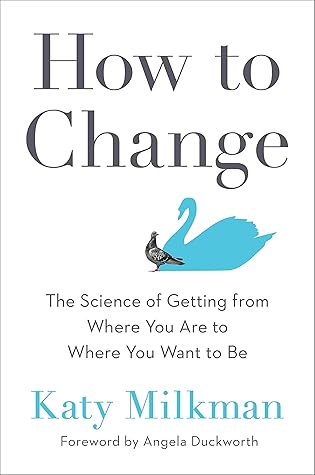More on this book
Community
Kindle Notes & Highlights
by
Katy Milkman
Read between
November 15 - November 25, 2021
whatever Katy cares about, she quickly learns how to do better and better, faster and faster, and more and more efficiently.
Katy copes with the same fallibilities we all share. She wants to eat cookies and potato chips instead of apples and spinach. She’d rather procrastinate than get back to work. She is capable of anger and impatience.
Katy approaches any of these challenges as problems to be solved.
widely touted techniques don’t always help you, or others, change.
You forget
You procra...
This highlight has been truncated due to consecutive passage length restrictions.
change is hard.
you haven’t found the right strategy.
we often fail by applying the wrong tactics in our attempts at change.
The surest path to success is not one-size-fits-all.
customize your strategy: isolate the weakness preventing progress,
behavioral economics—an
why people make flawed decisions.
humans make predictably imperfect decisions,
by nudging people toward objectively better choices
you could improve their lives
our small, daily failures to exercise or eat healthfully aren’t trifling human foibles, but rather are serious matters of life and death.
begin with a blank slate—a fresh start—and no old habits working against you.
labels matter to our behavior.
new beginnings offer a kind of psychological “do-over.” People feel distanced from their past failures; they feel like a different person—a person with reason to be optimistic about the future.
36 percent of successful attempts took place when people moved homes, whereas only 13 percent of unsuccessful attempts followed a move.
when we’re seeking to change, the disruptions to our lives triggered by physical transitions can be just as powerful as the fresh starts spurred by new beginnings on our calendars.
because they actually change our life circumstances—they
The bigger the landmark, the more likely it is to help us take a step back, regroup, and make a clean break from the past.
When we hope to change, we have an opportunity to try reshaping our environment to help us disrupt old routines and ways of thinking.
Maybe you like the idea of making a change, but actually doing it seems hard, and so you feel unmotivated to start.
fresh starts can help prompt small changes. But they can also inspire transformative change by giving you the will to try pursuing a daunting goal.
An ideal time to consider pursuing change is after a fresh start.
Fresh starts increase your motivation to change because they give you either a real clean slate or the impression of one;
Fresh starts can be calendar dates
They can also be triggered by meaningful life events,
when the metrics you’re using to track your perform...
This highlight has been truncated due to consecutive passage length restrictions.
to zero—can also offer fr...
This highlight has been truncated due to consecutive passage length restrictions.
Although fresh starts can jolt you into positive change, they can also interrupt you when you’re on a roll, rev...
This highlight has been truncated due to consecutive passage length restrictions.
Present bias (a.k.a. impulsivity)—the tendency to favor instantly gratifying temptations over larger long-term rewards—is a pernicious obstacle to change.
When goal pursuit is made instantly gratifying by adding “an element of fun,” present bias can be overcome.
Temptation bundling entails allowing yourself to engage in a guilty pleasure
only when pursuing a virtuous or valuable activity that...
This highlight has been truncated due to consecutive passage length restrictions.
Gamification
involves making something that isn’t a game feel more engaging and less monotonous by adding gamelike features such as symbolic rewards,
Present bias often causes us to procrastinate on tasks that serve our long-term goals.
anticipate temptation and create constraints (“commitment devices”) that disrupt this cycle.
Cash commitment devices are a versatile form of commitment device.
Public pledges are a form of “soft” commitment that increase the psychological cost of failing to meet your goals.
The softer the penalty or restriction, the less likely it is to help with change, but the more palatable it is to adopt.
Making smaller, more frequent commitments is more effective than making larger, less frequent ones, even when they amount to the same commitment (like saving 5 dollars a day as opposed to 1,825 dollars a year).
Not everyone recognizes how much they could benefit from a commitment device. Those who don’t (“naïfs”) tend to overestimate their ability to avoid temptation with willpower alone. Those who do (“sophisticate...
This highlight has been truncated due to consecutive passage length restrictions.
“implementation intention.” This fancy term actually refers to a fairly straightforward strategy


